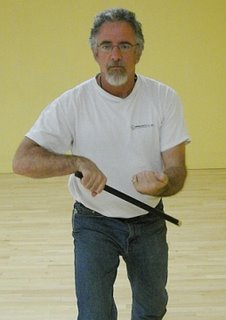Here’s how I teach the basic mechanics: I have my students hold their stick out in front around solar plexus level, using both hands pronate (palms downward) to grasp the ends. Simply open the left hand and let that end drop. With a moderate grip, the left end will fall to maybe a 30º angle so the stick is at a diagonal. The left hand stays level with the right hand.
Defenses are typically diagonal - think of kick blocks in empty-hand arts – since low attacks are often horizontal. A vertical triangle like this covers more of your body. The lock position also keeps the weapon in front of you, central to any direction very quickly. If you carry the weapon too vertical, for instance, you have little power to go further in that direction and a longer way down to protect low lines.
Relax your wrist, elbow and shoulder, without going limp. This lets your upper arm cover the ribs better, and you’ll be faster using whipping energy than muscles alone. This lock position might not feel natural at first, but it will. Don’t just push a strike; the strengths of a stick are extension and leverage, which create speed and power. Eventually we want our whole body integrated in each motion, taking advantage of mechanical torque and gravity as power multipliers.
Also consider how much you reach with your hands. A common mistake is to extend outward too far. Remember that your hand is a target, and the farther it reaches, the longer it takes to retrieve. Since the stick is faster than the hand, you’re more likely to get hit if caught reaching. As a general rule I teach our on-guard is from the elbow out. In other words, unless otherwise required, I let my upper arms drop to cover my ribs. I may hold them slightly towards the front of my body rather than more fully relaxed.
Now that we have a basic angle, height and reach, we need movement. The lock position is not static. It’s relational, a way to track and intercept incoming attacks. As Angel taught it, one hand is always moving towards the opponent while the other returns. To get the feel of this, jog in place while holding the stick in the right hand across your body. Notice how the hands naturally fall into a back-and-forth rhythm. This is similar to what you want. However, the movement is not exactly symmetrical, because the weapon should always protect the empty hand and so stays towards the front.
A common error is to reach more with the left hand than with the weapon. This exposes the hand unnecessarily and can possibly interfere with your own weapon being deployed. Keep that left hand behind your primary weapon unless it is being used tactically. After all, our bodies feel pain, our sticks do not, and it’s easier to replace the latter than fix a broken bone. Think of your stick as also being a shield, or perhaps as the bumper on your car, there to take impacts before you do.

I finally got blogger to upload a picture of the lock position facing forward
No comments:
Post a Comment